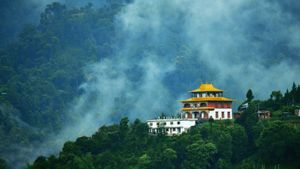Sikkim, the land of monasteries is a place where tradition and the incredible splendour of nature coexist harmoniously. The foothill of the mighty Himalayas is known for its biodiversity and diverse culture that reflects in the clothes of people who inhabit.
The traditional dress of Sikkim defines the deep rooted Nepali and Bhutani tradition. Sikkimese attire gracefully embraces modern influences, creating a unique fusion that mirrors the evolving tastes of its people. So, without elaborating a much – the glory of the dress of Sikkim, let’s hop on to explore their traditional clothing.
These are the traditional dresses of Sikkim
Bakhu
The traditional dress of Sikkim Bakhu is worn by people of Bhutan and Sikkim. In the Nepalese dialect the clothing style is known as Bakhu or Kho in the Bhutani dialect.
The dress form is quite similar to the Tibetan Chuba, however the only difference is Bakhu does not have sleeves. A belt assembled from silk or cotton tightens the garment around the waist, tying it loosely like a cloak around the neck. Sometimes to give the outfit a more western feel, women wear it with jeans.
These dresses are designed to be long and flowy, with a strong wool fabric that is appropriate for the chilly Himalayan climate.
Pharia
Dressing and styling in Pharia is favoured by women of Nepalese descent who reside in Sikkim, hence known to the traditional dress of Sikkim. The Bhutias typically wear long, loose-fitting shirts with knots on all four sides.
The Pharia, a traditional garment that accentuates the beauty of Nepalese women,
comes in a range of colours. Chaubandi Cholo, as the name suggests, is a long flowing blouse that is tied on four sides, just like with the Bhutias. Hembari, a piece of cloth with lovely designs, is beautifully wrapped around the upper body for extra coverage. They also utilise the Majetro shawl.
Nepalese ladies not only dance with Pharia on their heads but also adorn a colourful fabric hanging from their waists. Pachauri is the name of it.
Thokro-Dum
Thokro-Dum is a traditional dress of Sikkim which is typically worn by the Lepcha community. It's made up of a white pyjama that reaches the calves, giving it an almost martial arts fighter-like appearance. It is worn with Shambo, an embroidered cap, and Yenthatse, a Lepcha shirt. The Dumpra is a multicoloured, hand-woven textile that is fastened at one shoulder by a belt.
For the tribe, men's pyjamas hold particular significance due to their shortened length. It suggests that the men are indigenous to areas that are marshy. The robust and rugged texture of the material makes it perfect for a hard day out in the field.
The Thyaktuk and related varieties are finely crafted hats that remain unique and loyal to their ancient origins. With the exception of Anok Thakytuk, which is made of lovely velvet fabric, these hats are often crafted from fine canes.
Dumvum
The Dumvum, also called the Dumyam, is a sari-like garment that is part of Lepcha women's traditional clothing. This elegant, seamless ankle-length ensemble unites comfort with culture. Tago, a loose-fitting blouse in a contrasting colour, is worn underneath. A headgear and a belt style known as the Nyamrek and Taro are worn to finish the ensemble. A gorey scarf is frequently worn as a head covering.
The differences between Lepcha men's and women's clothes are fascinating. The female costume is made of a gentler, lighter cloth that makes the outfit elegant and feminine, while the male costume is harsh and made for the hard nature of their labour in the fields and forests.
Shuruval
Sikkim's Nepalese males dress in Shuruval. Below the waist, a long, double-breasted dress flows into a pair of pants. The pyjama (shirt) is called Daura, and the churidar (bottom) is called Shuruval. To go with the Shuruval, Askot, a waistcoat, and Patuki, a belt are worn. Additionally, they carry the Khukri, a hefty weapon kept in a leather box called a Daab.
Photo: shutterstock


_1704533052783_thumb_1200.jpeg?w=3840&q=75)
_1682538629098_thumb_300.png?w=3840&q=75)
_1682326260554_thumb_300.png?w=3840&q=75)
_1682412740759_thumb_300.png?w=3840&q=75)
